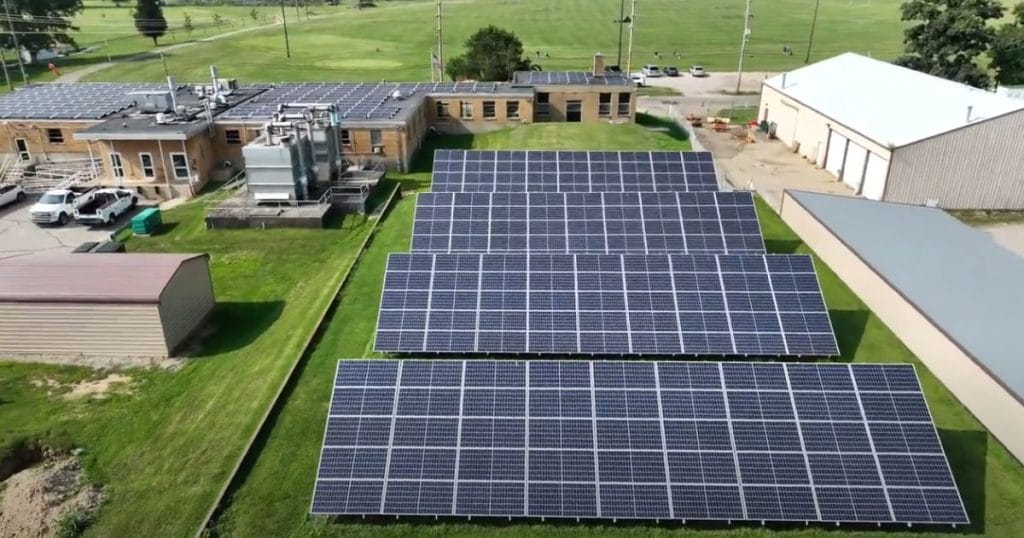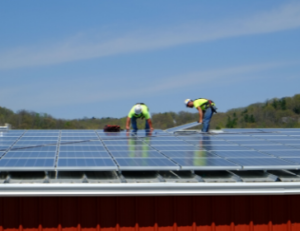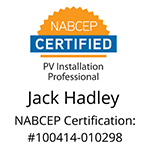Consider greening your home before you go solar for maximum savings! The average American spends $2,000 annually on energy expenses. Some of that expense goes to waste because of leaky faucets, air drafts, and outdated heating and cooling appliances. You can reduce these losses through energy efficiency upgrades.
If you plan to go solar eventually, there is an added benefit in completing energy efficiency upgrades before going solar.
When you reduce your electric consumption in your home, you reduce the amount of electricity your solar panels must generate to match your household usage.
Remember – every home is different. The suggestions, cost estimates, and impact estimates provided in this post are general. But they should get you started thinking about energy efficiency upgrades to make before you go solar.
In this greening your home before you go solar guide, you will find information about:
- Hot Water Heater Blankets
- Hot Water Temperature Cards
- LED Lightbulbs
- SMART Thermostats
- Attic Insulation
- Attic Staircase Covers
- Energy Efficient Power Strips
- Low Flow Faucet Aerators
Hot Water Temperature Card
- Cost: $5 – $10
- Impact: Lowering a hot water heater 10 degrees saves 3-5% in energy costs annually
A Hot Water Temperature Card is an educational device designed to inform you if your water tank’s temperature is set higher than necessary.
If your water heater’s temperature is set higher than is appropriate, the opportunity exists to reduce energy costs by lowering the temperature. If the temperature is higher than 120°F, the water heater is set too high.
A bonus of a hot water temperature card? Keeping your hot water in a lower range can prevent tap water scalding.
LED Lightbulbs
- Cost: ~ $20
- Impact: Changing out 5 of your most frequently used bulbs for LEDs could save you up to $75 annually
You’ve probably heard from your utility company that you need to make the switch to LED lightbulbs. They’ve been a hot topic for several years, with good reason.
Get this: LED bulbs use about 75%–80% less energy than traditional bulbs.
Additionally, LED bulbs have a longer life expectancy than most other lighting, saving you energy and lasting longer.
SMART Thermostat
- Cost: $50 – $200
- Impact: You can save as much as 10% a year on heating and cooling by simply turning your thermostat back 7°-10°F for 8 hours a day from its typical setting
SMART Thermostats take the work out of the equation for you – ensuring that the thermostat gets changed. Like clockwork, a SMART thermostat turns the heat or AC down when you leave — depending on the season.
Although you can adjust thermostats manually, SMART thermostats will avoid any discomfort by returning temperatures to normal before you wake or return home.
The lower the interior temperature, the slower the heat loss. So, the longer your house remains at the lower temperature, the more energy you save because your home has lost less energy than it would have at the higher temperature.
The same concept applies to raising your thermostat setting in the summer — a higher interior temperature will slow the flow of heat into your house, saving energy on air conditioning.
Attic Insulation
- Cost: $1 – $1.50 per square foot, $1,000 – $1,500 total for an average home
- Impact: The “EPA estimates that homeowners can save an average of 15% on heating and cooling costs (or an average of 11% on total energy costs) by air sealing their homes and adding insulation in attics, floors over crawl spaces, and accessible basement rim joists.” According to Energy Star
Resources:
- Methodology for Estimated Energy Savings from Cost-Effective Air Sealing and Insulating
- How Much Does Blown-in Insulation Cost?
- Read This Before You Insulate Your Attic
- Where to Insulate in a Home
- Green Living: Spray foam insulation keeps homes warmer, but beware of these common problems
Attic staircase cover
- Cost: $100 – $150
- In many homes, leaky attic access stairs provide an opportunity to improve comfort and save energy and money.
You can seal and insulate the attic stairs opening by building your insulated cover box or purchasing a kit or pre-built package.
Approach the attic stairs access as you would an opening to the outdoors. Regardless of the type of insulation you use for your attic access, it is important to thoroughly air seal the gap.
Energy Efficient Power Strips
- Cost: $20 – $50 per unit
- Impact: up to $200 for an average home
The purpose of energy-efficient power strips is to reduce phantom loads.
Phantom loads continue to consume energy even when your devices are not in use.
For instance, your TV, computer, and cable box all use energy even when they’re turned off.
Smart power strips actually cut the power off and save energy since they can detect when a device is in off mode.
Low Flow Faucet Aerators & Shower Heads
- Cost: $5 – $40
- Impact: A 1.0-gallon per minute aerator can save more than 50 percent of the water you use. You can save anywhere from 2 to 16 gallons of water per day based on your average daily water use and the aerator you choose to install
The easiest way to begin saving water is to change the faucet aerator on your kitchen and bathroom faucets and showerheads to a water-saving low-flow faucet aerator.
A water aerator is a disc-shaped screen placed at the end of the faucet that is removable by turning on or off the threaded end of the spout. It’s designed to break up the water flowing through the faucet into several small streams while introducing air into the water flow.
This process saves water with no noticeable reduction in water pressure. Saving water saves money, especially on the energy you use to heat it.
Greening Your Home Before You Go Solar…
These steps can get you on the right path to reducing your annual electricity consumption. And, when it’s time for you to go solar, you’ll be even more self-sufficient.
We know that investments in energy efficiency will pay off in the long run.
Reach out when you’re ready to learn more about installing a solar energy system at your home.



















